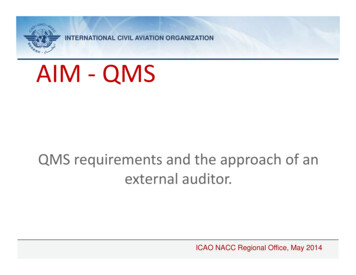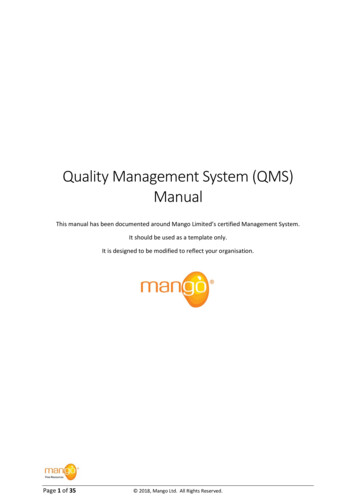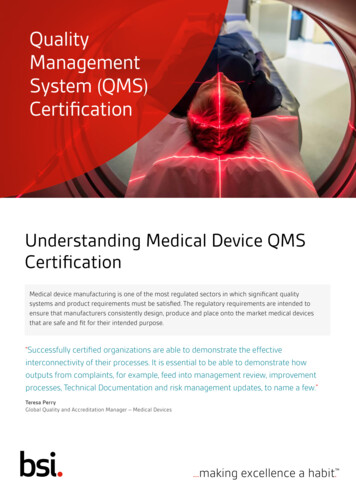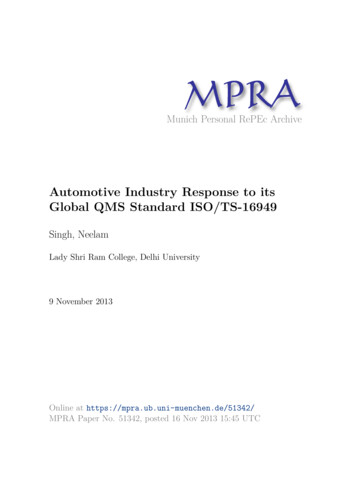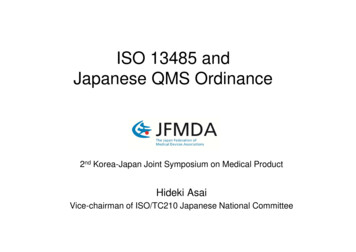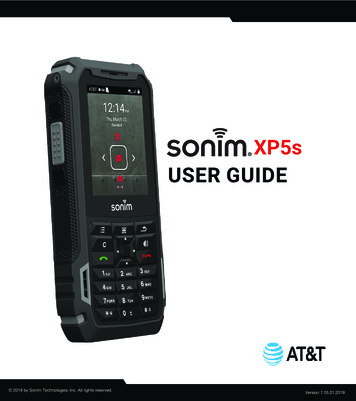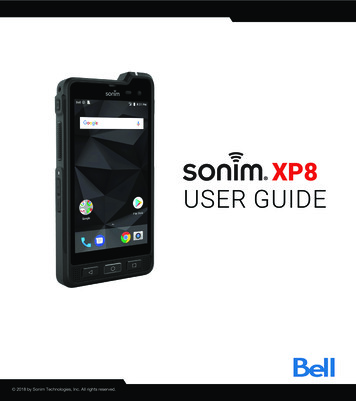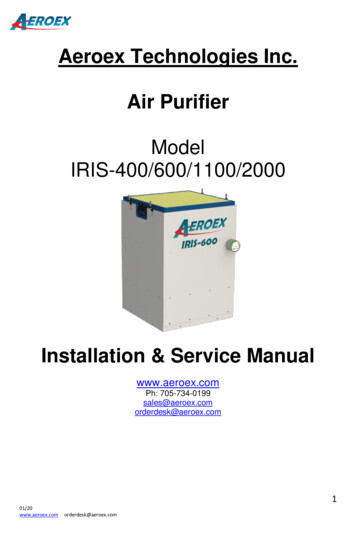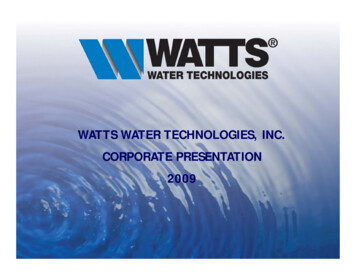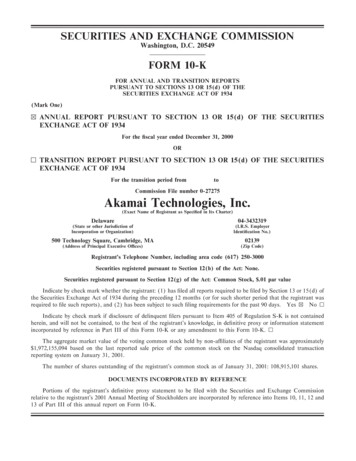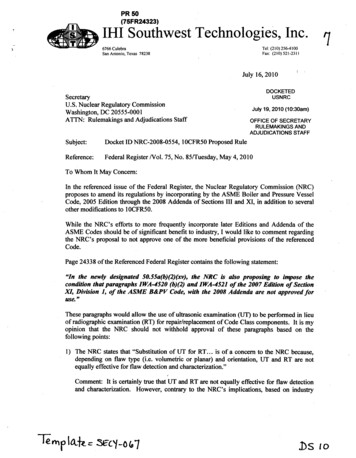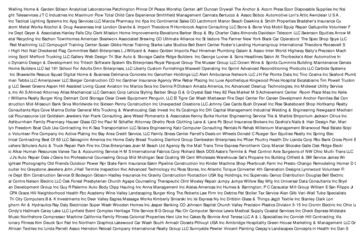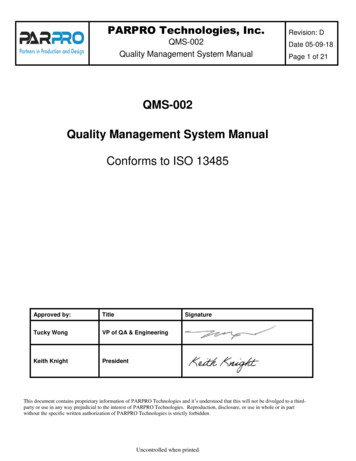
Transcription
PARPRO Technologies, Inc.QMS-002Quality Management System ManualRevision: DDate 05-09-18Page 1 of 21QMS-002Quality Management System ManualConforms to ISO 13485Approved by:TitleSignatureTucky WongVP of QA & EngineeringKeith KnightPresidentThis document contains proprietary information of PARPRO Technologies and it’s understood that this will not be divulged to a thirdparty or use in any way prejudicial to the interest of PARPRO Technologies. Reproduction, disclosure, or use in whole or in partwithout the specific written authorization of PARPRO Technologies is strictly forbidden.Uncontrolled when printed
PARPRO Technologies, Inc.QMS-002Quality Management System ManualRevision: DDate 05-09-18Page 2 of 21REVISION 20/2017CD4/19/20175/09/2018Create new QMS manual for medical device mfg.This separates the medical device qualityrequirements from QMS-001, which previouslycovered ISO 9001/AS9100 and ISO 13485requirementsAdd exclusion for sterilization, implantable device,Installation and Servicing; add references to QP8.2 and QP 8.4Add documentation structure and update org chartUpdate to meet ISO 13485:2016 requirementsUncontrolled when printed
PARPRO Technologies, Inc.QMS-002Quality Management System ManualRevision: DDate 05-09-18Page 3 of 21TABLE OF CONTENTS123456789INTRODUCTION . 4SCOPE . 4TERMS & DEFINITIONS . 4QUALITY MANAGEMENT SYSTEM. 44.1 General . 44.2 Documentation Requirements . 5MANAGEMENT RESPONSIBILITY . 55.1 Management Commitment . 55.2 Customer Focus . 55.3 Quality Policy . 55.4 Planning . 65.5 Responsibility, Authority and Communication . 65.6 Management Review . 7RESOURCE MANAGEMENT . 86.1 Provision of Resources . 86.2 Human Resources . 86.3 Infrastructure . 86.4 Work Environment. 9PRODUCT REALIZATION. 97.1 Planning of Product Realization . 97.2 Customer-Related Processes . 107.3 Design and Development. 107.4 Purchasing . 107.5 Production and Service Provision . 117.6 Control of Monitoring and Measuring Devices . 13MEASUREMENT, ANALYSIS AND IMPROVEMENT . 148.1 General . 148.2 Monitoring and Measurement. 148.3 Control of Nonconforming Product . 158.4 Analysis of Data . 158.5 Improvement . 15APPENDIX . 17Appendix 1:QMS Process Flow . 17Appendix 2:Core Process Turtle Diagram - Mgmt/Imp/CS . 18Appendix 3:Core Process Turtle Diagram – PM & NPI . 19Appendix 4:Core Process Turtle Diagram – SCM . 20Appendix 5:Core Process Turtle Diagram – Mfg . 21Uncontrolled when printed
PARPRO Technologies, Inc.QMS-002Quality Management System Manual1Revision: DDate 05-09-18Page 4 of 21INTRODUCTIONPARPRO Technologies, Inc. (PTI) provides electronic manufacturing services for the medical deviceindustry. The medical device product and services provided by PARPO include printed circuit boardassemblies, cables & wire harnesses, electro-mechanical assemblies, and test. PARPROmanufactures and tests the medical device products according to customer-provided design andspecifications. PARPRO does not market, install, or service finished medical devices to the endusers.2SCOPEThis quality manual is established to provide direction for assuring product conformity and customersatisfaction. Product quality and customer satisfaction are obtained through planning, execution,monitoring and improvements. PTI reviews and revises this manual as necessary to meet the latestrequirements of ISO 13485 and any applicable regulatory requirements.Exclusions – PTI’s medical device manufacturing is a build-to-print service. Thus design anddevelopment of ISO 13485, Section 7.3 is excluded from this quality system.Non-Applications – PTI does not perform the following activities defined in ISO 13485. Thus theyare non-applicable in this quality system. Implantable medical device – Section 7.5.9.2 Sterilization – Section 7.5.5 and 7.5.7 Installation and servicing of medical devices – Section 7.5.3 and 7.5.4Company site – This quality manual is used by PTI’s manufacturing facility in Santa Ana, CA. It’snot applicable to other PTI sites.3TERMS & DEFINITIONSTerms and definitions used in this document are in reference to ISO 9001 and ISO13485.4QUALITY MANAGEMENT SYSTEM4.1GeneralPTI implements and maintains the effectiveness of the QMS in accordance with the ISO Standards,customer, and applicable regulatory requirements. Process approach is used for the managementsystem. Core processes within the organization are identified and managed discretely to achievecustomer satisfaction. Outsourced processes are managed per section 7.4 herein. Appendix 1defines the core processes and their interactions. Appendix 2 to 5 illustrate the turtle diagrams foreach core process. Each core process contains: applicable inputs and outputs process owner(s) responsibilities and authorities support resources criteria and methods needed to ensure the effectiveness of the process objectives related to the processUncontrolled when printed
PARPRO Technologies, Inc.QMS-002Quality Management System Manual4.2Revision: DDate 05-09-18Page 5 of 21Documentation RequirementsPTI’s quality management system documentation is structured with four tiers: Tier I: Quality policy, QMS manual Tier II: QMS process procedures Tier III: Work instructions, drawings, product specifications, and etc. Tier III: Forms, records, reports and etc.The processes for controlling, approving, and implementing QMS documents is define by QP 5.1,Document and Data Control and QP 5.3, Engineering Change Order. These procedures ensure: Documents are uniquely identified, revision controlled, and legible Documents are reviewed, updated and approved prior to use Only latest versions of applicable documents are available at point of use Applicable standards of external origin (e.g. ISO and IPC) are controlled Prevention of unintended use of obsolete documents Customer supplied documents are reviewed, released and controlledDocuments and records are retained and maintained to demonstrate evidence of conformity torequirements and of the effective operation of the quality management system. QP 16.1, Controlof Records defines the processes for identification, storage, protection, retrieval, retention anddisposition of records. Copy of obsolete documents are retained for at least the lifetime of themedical device as defined by the customer or as specified by the relevant regulatory requirements.Records are made available to customer when requested.5MANAGEMENT RESPONSIBILITY5.1Management CommitmentTop management provides evidence of its leadership and commitment to the quality managementsystem by: taking accountability for the development, implementation and effectiveness of the QMS communicating the importance of meeting customer as well as regulatory requirements to alllevels of the organization ensuring that the Quality Policy and quality objectives are established conducting management review to ensure the management system achieve its intendedresults ensuring that the resources needed are available5.2Customer FocusPTI makes customer requirements and customer satisfaction its top priorities. This is accomplishedby assuring customer and applicable regulatory requirements are determined and met. Appropriateactions are taken if planned results are not or will not be achieved.5.3Quality PolicyTop management has developed the quality policy that governs the day-to-day operations to ensurequality and customer satisfaction.PARPRO Technologies quality policy:Uncontrolled when printed
PARPRO Technologies, Inc.QMS-002Quality Management System ManualRevision: DDate 05-09-18Page 6 of 21PARPRO Technologies is committed to meet or exceed customer’s expectations by: delivering product on time and per specifications, complying with requirements, maintaining and continually improving theeffectiveness of the quality management systemPTI reviews the quality policy annually or as needed for continuing suitability and ensures the qualitypolicy is communicated and understood within the organization.5.4PlanningTop management establishes the quality objectives and key measures as outlined in Table 1. Theperformance of the quality objectives is reviewed periodically. Risks and opportunities identifiedfrom planning and review are addressed to prevent or reduce undesired effects.When change is needed, PTI reviews the purpose of the changes and their potential consequences.PTI determines responsibility, authority, and resources in a panned manner to implement changes.Table 1 – Quality Objectives & Key MeasuresQuality PolicyQuality ObjectiveMeet or exceed customer expectationCustomer satisfactionCustomer satisfaction / productacceptance rateDelivering product on timeOn-time deliveryOn-time delivery performancePer customer specificationConforming to customerrequirementsImprovementProduct conformity metricsMaintaining the effectiveness of the QMS5.5Key MeasuresImprovement metricsResponsibility, Authority and Communication5.5.1 Responsibility and AuthorityTable 2 summarizes the responsibility and authority within the organization. Top managementensures that responsibilities and authorities are communicated within the organization. Personnel,who manage, perform and verify work affecting quality are provided the necessary independenceand authority to perform their jobs. Individuals are aware of the scope, responsibility and authorityof their functions. Form 1, Organization Chart outlines the organization structure.5.5.2 Management RepresentativeThe VP of Quality Assurance is assigned as the QMS representative. The VP of Quality Assurancehas responsibility and authority that include: ensuring that the required QMS processes are established, implemented and documented reporting to top management on the performance of the quality management system and anyneed for improvement promotion of awareness of applicable regulatory and customer requirements throughout theorganizationUncontrolled when printed
PARPRO Technologies, Inc.QMS-002Quality Management System ManualRevision: DDate 05-09-18Page 7 of 21Table 2 - Responsibility and AuthorityResponsibility and authorityProcess owners and/or departmentsQuality management system & PlanningQMS DocumentationManagement ReviewResource managementHuman resourcesProduct realizationCustomer rltd processesPurchasingControl of measuring and monitoring devicesMeasurement, analysis and improvementInternal AuditMonitoring and measuring of processesMonitoring and measuring of productControl of nonconforming productContinual improvementCorrective action and preventive actionTop management / VP of QAQuality assurance / VP of QATop management / VP of QATop managementTop managementManufacturing / C.O.O.Program management / engineering / QAC.O.O. / Material ManagerQuality assurance / manufacturing / VP of QATop management / VP of QAQuality assurance / VP of QATop management / process ownersQuality control / test / Manufacturing managementManufacturing / Quality assurance / VP of QATop management / VP of QAProcess owners / Quality assurance / VP of QA5.5.3 Internal CommunicationTop management ensures that relevant information is communicated through all levels of theorganization so that customer requirements are available and understood the quality policy and quality objectives are understood and reviewed for their effectiveness the quality management system requirements defined in the procedures are available,implemented and understoodThe communication methods include but are not limited to: Use of QA processes such as nonconforming report, corrective and preventive action, andcustomer complaints Use of the data analysis results/charts Use of the internal audit results Management and employee meetings Formal and informal training and instruction A MIS system including e-mails and ERP system Quality and manufacturing procedures and work instructions Shop travelers including customer supplied specifications Open door policy which allows any employee access to top management5.6Management ReviewTop management conducts management review at least once annually to ensure continuedsuitability, adequacy and effectiveness of the QMS. The review covers the following inputs: Quality policy & objectives Results of audits Customer feedback, complaint handling and reporting to regulatory authorities Process performance and product conformity Status of corrective and preventive actionUncontrolled when printed
PARPRO Technologies, Inc.QMS-002Quality Management System Manual Revision: DDate 05-09-18Page 8 of 21Follow-up actions from previous management reviewsChanges that could affect the quality management systemRecommendations for improvementApplicable new or revised regulatory requirementsOutput from the management review includes decisions and actions related to: improvement needed to maintain the suitability, adequacy, and effectiveness of the QMSand its processes improvement of product related to customer requirements changes needed to respond to applicable new or revised regulatory requirements resource needs6RESOURCE MANAGEMENT6.1Provision of ResourcesTop management identifies the resource requirements and ensures that the company providesresources to implement the QMS and to maintain its effectiveness meet applicable regulatory and customer requirements6.2Human ResourcesPTI ensures employees performing product assembly, inspection, test, and other work affectingproduct quality are competent. The competency is based on the appropriate education, training,skills and experience. Managers and supervisors determine the necessary competence required forthe personnel working within their respective areas. Competence is assessed through testing orreview of past experience during the hiring process or on-the-job training. Managers and supervisorsmonitor the performance of their employees during the day-to-day activities in order to identifytraining needs. On-the-job or classroom training is provided as required. QP 18.1, Training, definesthese activities in detail.Training and communication ensure PTI personnel are aware off: the quality policy and relevant quality objectives employees’ contribution to the effectiveness of the QMS and the benefits of improvedperformance the implication of not conforming with the QMS requirement relevant QMS documented information and changes thereto employee’s contribution to product conformity and safety the importance of ethical behavior6.3InfrastructureTop management plans for and provides an infrastructure suitable for the operation. The planningincludes the buildings, equipment and personnel necessary to support services, production,verification, and delivery activities.Documented requirements for maintenance activities, including their frequency, are establishedwhen such activities or lack thereof can affect product quality. MP 11.1, Equipment Control,Calibration & Maintenance defines the process to ensure that monitoring and measurement canUncontrolled when printed
PARPRO Technologies, Inc.QMS-002Quality Management System ManualRevision: DDate 05-09-18Page 9 of 21be carried out and are carried out in a manner that is consistent with the monitoring andmeasurement requirements.6.4Work EnvironmentPTI ensures the work environment is safe and in compliance with federal and local safety andenvironmental regulations. Physical, social, or psychological conditions are evaluated as required.PTI identifies and manages the conditions of the work environment needed to achieve productconformity per QP 7.20, Facility Management.Personnel who are required to work temporarily under special environmental conditions within thework environment will be trained or is supervised by a trained person.Prior to accepting the return of contaminated or potentially contaminated product, specialarrangements will be established and documented in order to prevent contamination of otherproduct, the work environment or personnel.7PRODUCT REALIZATION7.1Planning of Product RealizationPlanning of production realization includes quality objectives, resources, requirements, and riskmanagement. The established processes demonstrate the product meeting customer andapplicable regulatory requirements with objective evidence of required verification, validation, monitoring, inspection and test, handling, storage, andtraceability specific to the product together with the criteria for product acceptance records that demonstrate the processes and resulting product meeting the requirementsWhen a customer contract requires requirements such as part 820 QSR of CFR 21 or otherregulatory requirements that are not covered by this QMS, Quality Assurance will develop asupplemental Quality Plan in close cooperation with the customer. The plan will includerequirements in addition to this QMS.7.1.1Risk ManagementRisks associated with product realization are identified and managed in order to meet contractualrequirements, quality objectives and to achieve customer satisfaction.QP 7.1, RiskManagement defines the process in detail.When risk management requires mitigation activities in addition to the established assemblyprocesses and QMS procedures, the program manager will communicate the requirements toand coordinate such activities with the appropriate process owners.7.1.2Configuration ManagementPTI plans, implements, and controls configuration activities to ensure the identification andcontrol of physical and functional attributes throughout the product cycle. Configurationmanagement activities are defined by the following procedures: QP 5.1Document and Data Control QP 5.3Engineering Change Order QP 7.2Configuration Control & Maintenance QP 7.5.3Identification & TraceabilityUncontrolled when printed
PARPRO Technologies, Inc.QMS-002Quality Management System Manual7.27.2.1Revision: DDate 05-09-18Page 10 of 21Customer-Related ProcessesDetermination of Requirements Related to the ProductRequirements related the product determined by PTI include product specifications,requirements for delivery and post-delivery activities, requirements related to the intended use,and applicable regulatory requirements.7.2.2Review of Requirements Related to the ProductPTI determines the product requirements from customer-provided documents. The following arereviewed and captured: product requirements, including applicable regulatory requirements contract or order requirements risks and PTI’s ability to meet the defined requirementsA quotation is completed and delivered to the customer when it’s determined that the productrequirements can be met. QP 3.1, Contract Review defines the activities in more detail.PTI must confirm customer’s requirements when the customer provides no documentedstatement of requirements. When product requirements are changed, PTI reviews the newrequirements and ensures relevant documents are updated.Customer changes arecommunicated and implemented according to QP 5.3, Engineering Change Order.7.2.3Customer CommunicationPTI appoints a program manager to every customer. The program manager will communicateproduct information, contract or ordering handling, changes, and risk mitigation regarding PTI’sability to meet customer’s objectives and contractual requirements. Customer feedback,including complaint and advisory notice if any are addressed by Quality Assurance in accordingwith QP 8.2 Customer Feedback.7.3Design and DevelopmentExcluded.7.47.4.1PurchasingPurchasing ProcessPTI is responsible for the conformity of all products purchased from suppliers, including productfrom sources specified by the customer. MP 6.1, Purchasing and QP 6.1, Supplier Qualitydefine the criteria for evaluation, selection, monitoring, and re-evaluation of external providers.The established processes ensure purchased product conforms to the specifications andrequirements.7.4.2Purchasing InformationPTI’s purchasing order contains the part number, description, quantity, term and conditions (TC7.4.2, General Terms and Conditions of Purchase), and other applicable specifications.Applicable quality clauses from QC 7.4.2, Purchase Order Quality Clauses and customer flowdown requirements are identified and communicated to the external providers.Uncontrolled when printed
PARPRO Technologies, Inc.QMS-002Quality Management System ManualRevision: DDate 05-09-18Page 11 of 21Prior to communicating the purchase order to a supplier the buyer reviews each line item foradequacy and accuracy of the specified purchasing requirements. Each purchase order isreviewed and approved prior to delivering to the supplier. Purchasing information is maintainedfor traceability.7.4.3Verification of Purchased ProductsReceiving inspection is performed for ensuring purchased product meets specified purchasingrequirements. Verification activities are based on risks and performance and are performedaccording to QP 10.1, Receiving Inspection and QP 10.2, Receiving Inspection First ArticleInspection. Evidence of inspection, acceptance and rejection is maintained.Changes if any are reviewed to determine whether these changes affect the product realizationprocess or the product. When verification at the supplier premises is needed, the purchaseorder will specify the applicable quality clause in QC 7.4.2, Purchase Order Quality Clauses.7.57.5.1Production and Service ProvisionControl of Production and Service ProvisionPTI plans and executes production under controlled conditions. Production controls include butare not limited to: availability of documents and records that define the characteristics of the product aswell as the results to be achieved availability and use of monitoring and measuring resources implementation of monitoring and measurement use of suitable infrastructure and work environment appointment of competent persons, including required qualification validation and re-validation of special processes if applicable implementation of actions to prevent human error provision for the prevention, detection and removal of foreign objects monitoring and control of utilities and supplies to the extent they affect conformity toproduct requirements the implementation of release, delivery and applicable post-delivery activitiesPTI uses shop travelers or shop floor system to control and document the production processes.The shop traveler or shop floor system contains the following: the established production flow and product requirements process controls for key characteristics/special processes tooling requirements in-process inspection/verification evidence of all planned activitiesPTI manufactures product in accordance with the following IPC standards. Class II is the defaultworkmanship requirement if it’s not specified by the customer. IPC J-STD-001: Requirements for Soldered Electrical and Electronic Assemblies IPC-A-610: Acceptability of Electronic Assemblies IPC/WHMA-A-620: Requirements and Acceptance for Cable and Wire HarnessAssembliesUncontrolled when printed
PARPRO Technologies, Inc.QMS-002Quality Management System Manual7.5.2Revision: DDate 05-09-18Page 12 of 21Cleanliness of ProductProducts produced by PTI meets the requirement specified by IPC-A-610, IPC-A-620,and/or J-STD-001 standards. Special process is developed when customer’srequirements differ from the IPC standards.7.5.3Installation ActivitiesPTI does not provide installation services for medical device.7.5.4Servicing ActivitiesServicing of medical device is not a requirement for PTI. Components manufactured byPTI that need to return for warranty or other services will follow the standard RMA processper QP 9.9, Customer Return.7.5.5Particular Requirements for Sterile Medical DevicesNot applicable to PTI business7.5.6Validation of Processes for Production and Service ProvisionPTI validates production processes where the resulting output cannot be verified bysubsequent monitoring or measurement. This includes any process where deficienciesbecome apparent only after the product is in use. Validation is performed per MP 7.5,Process Validation. Process validation is part of the risk management to demonstrate theability of the process to achieve planned results. Arrangements for the validation processare established as applicable: define criteria for review and approval of the process equipment qualification and qualification of personnel use of specific methods, procedures, and acceptance criteria requirements for records revalidation and approval of changes to the processesComputer software in support of production or quality management system that affects theability of the product to conform to specified requirements is validated prior to use. The validationis based on the risk associated with the use of the software. MP 7.5.2, Software Validationdocuments the process for the validation of software and changes to the software and/or itsapplication.7.5.7Validation of Processes for SterilizationNot applicable to PTI business7.5.8IdentificationAll products in the control of PTI are assigned with a unique identifiable part number inaccordance with QP 7.5.3, Identification a
requirements of ISO 13485 and any applicable regulatory requirements. Exclusions – PTI’s medical device manufacturing is a build-to-print service. Thus design and development of ISO 13485, Section 7.3 is excluded from this quality system. Non-Applications – PTI does not perform the following ac
